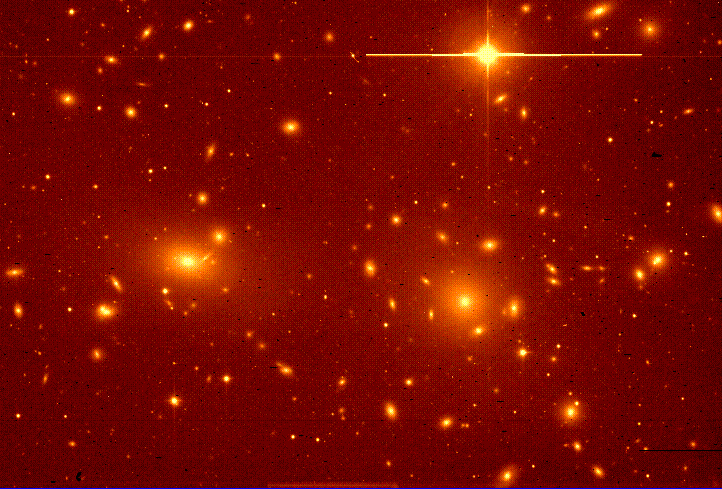
We have found out that astronomical objects like to be found near each other. Planets are found around stars, and many stars are formed-in, or are found in clusters of stars, and clusters of stars congregate in the disks of galaxies, or orbit around galaxies, and smaller galaxies orbit bigger galaxies, and loose associations of galaxies, such as the Local Group, also exist. Are there still larger structures? Yes!
While there are some isolated galaxies in the Universe, most galaxies in the Universe are found in small groups (like the Local Group), or in/near clusters of galaxies. What does a cluster of galaxies look like? Like a cluster of stars, only instead of stars, we have dozens, hundreds, or even thousands of galaxies:

95% of the objects you see in this photograph are not stars, but galaxies! This cluster, called Coma, is one of the biggest ("richest") clusters of galaxies. It contains over 1,000 members. Note that the majority of the galaxies in this cluster are small--there are many more small galaxies than large galaxies. This is true everywhere in the Universe---just like in our Milky Way galaxy where low-mass stars dominate, the Universe is dominated by small galaxies--at least there are more of them by number (but maybe not by mass, since one giant elliptical is worth a million dwarf spheroidals). It is not very clear from this picture, but spiral galaxies are quite rare inside rich galaxy clusters, this close-up (Fig. 22.11) of another cluster demonstrates this more clearly:

The spirals in this cluster are the bluer galaxies. Large clusters of galaxies are dominated by elliptical and S0 galaxies. We believe this results from two effects: the first is that many more mergers probably took place in the past inside galaxy clusters, and mergers produce elliptical galaxies. The second is that there is a thin gas that permeates the galaxy cluster, and just like globular star clusters orbiting around our galaxy, these galaxies orbit around the center of the galaxy cluster. As they do so, the gas inside the galaxies is stripped-out by the gas pressure. It is like wind blowing the dust out of a pile of dirt and sand; the lighter stuff is blown away, while the larger, and heavier pieces (the stars) stay put. If you blow away all of the gas and dust in a spiral galaxy, you are left with an S0! This gas (sometimes called the "intracluster medium") is very hot, and emits x-rays. Here is an X-ray image (left) and an optical image of the Coma cluster (Fig. 22.8):

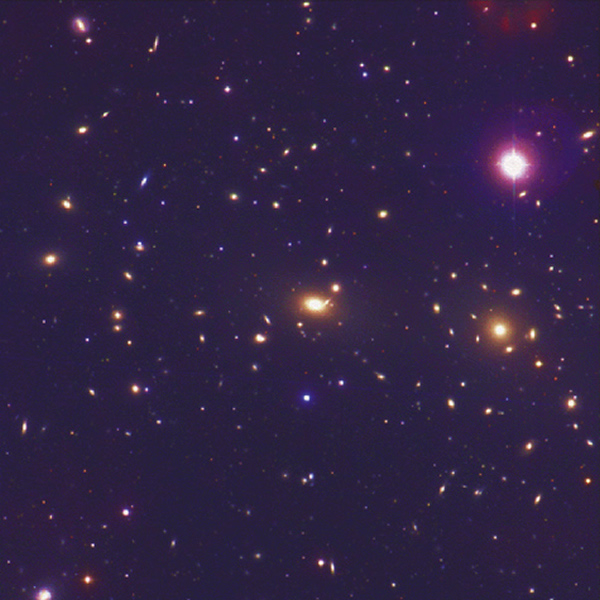
The X-ray gas fills the space between the galaxies. Because this gas is hot, it should escape from the cluster because there is not enough matter contained in the cluster galaxies to exert sufficient gravitational force on the gas to keep it confined in the cluster. This finding was quite a surprise to astronomers. When they calculated the mass required to keep the hot X-ray emitting gas inside the galaxy cluster, and then calculated the mass of all of the visible galaxies on their cluster images, they found that only 10% of the necessary mass was visible (in the form of galaxies). This result was supported by earlier work on the motions of galaxies that showed they were orbiting around the cluster centers at higher velocities than they should be, given the observed masses of the clusters. It was as if some large, unseen object was sitting at the middle of the cluster, increasing the gravitational pull on each individual galaxy.
Where could this mass be hiding? Astronomers do not know the answer to that question. We simply refer to this missing mass as "dark matter". It is some exotic form of matter that does not emit light. It is exotic, because nothing we know about behaves this way--remember that even black holes reveal themselves through the interaction with stars and gas clouds--thus, this dark matter is highly unusual. It remains one of the major unsolved mysteries in astronomy. This dark matter appears to permeate the entire Universe, and makes up 90% of the matter in our Universe. We cannot see/detect the most abundant constituant of our Universe! Very unsatisfactory. We will encounter some equally curious things about our Universe over the next two weeks. (For more on the search for dark matter, go here.)
Back to galaxy clusters. We now know that galaxies generally like to congregate together---whether it is only a small cluster like our Local Group, containing a few dozen members, or a rich cluster like Coma containing thousands of galaxies, most galaxies are found near other galaxies. But this is not the end, there are even larger structures: it appears that galaxy clusters tend to cluster! We call these "superclusters". When you plot the position of galaxies in the sky, you find large strands of galaxy clusters:
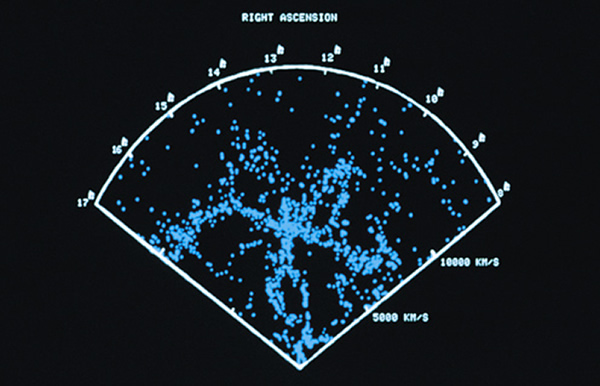
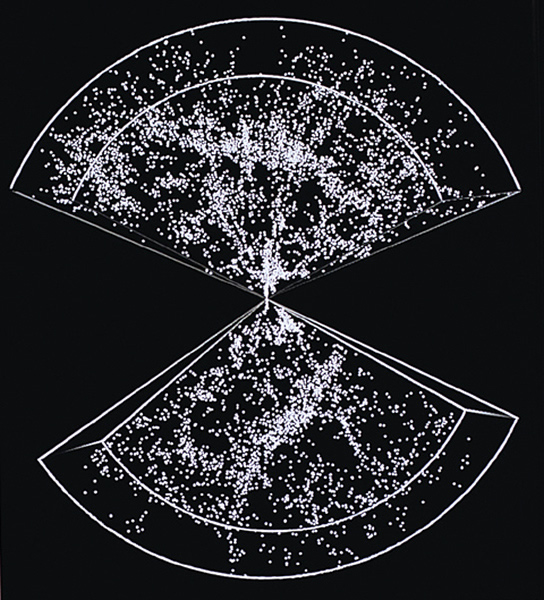
The distribution of galaxy clusters is very clumpy, with large groups and strings of clusters. If we look on even larger scales, we find that the distribution of galaxies is like that of a foam:
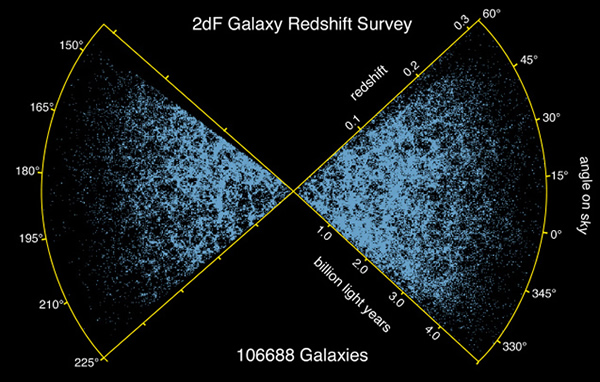
There are "bubbles" or "voids" where there are few galaxies, and more concentrated regions with many galaxies, with strings or filaments of galaxies connecting the largest clusters together, as shown in this mathematical model (Fig. 22.16b):
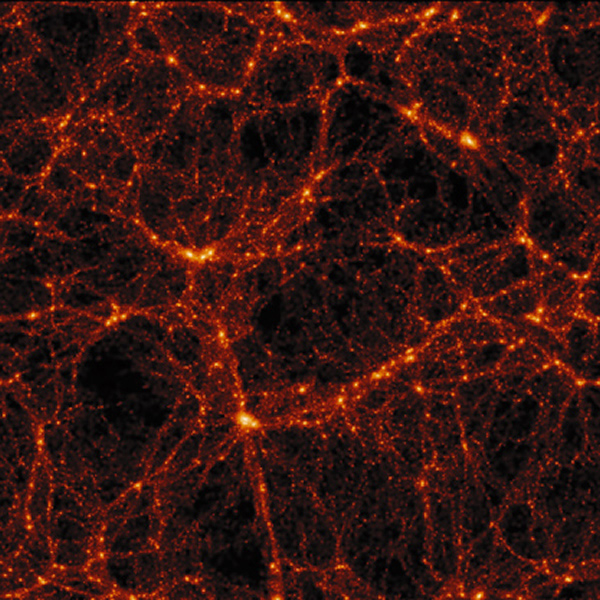
These filaments and voids are the largest structures in the Universe, and can extend across 50 million light years or more! We have now reached a limit--the only thing bigger than these features is the Universe in which they exist. A quick flight through the Universe. (another), (and another)
We now begin the final leg of our journey: to attempt to understand where the Universe came from, and where it is headed. We begin this trip by trying to answer two simple questions: The paradoxes of Olber and Newton.
In 1823 the German astronomer Heinrich Olbers asked a rather simple question: Why is the sky dark at night? While this question may seem easy, and straightforward (the Sun is not up), it is actually very deep, and will take several lectures for us to properly answer. Why? Think about this proposition: if the Universe is infinite in size, and populated with a uniform distribution of galaxies, all containing many billions of stars, than in every direction you look, your line-of-sight will intercept the surface of a star:
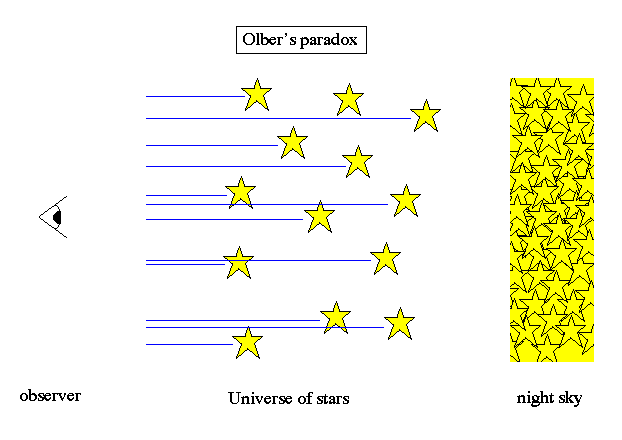
The combination of many extremely faint stars seen along any line drawn in an infinite universe must intercept the surface of a star, so every inifintely minute spot in the sky will be occupied by the surface of a star, and thus, the night sky should glow with the intensity of the surface of the Sun. Thus, why is the sky dark at night? Not an easy question after all!
Well, we know dust exists in our galaxy, and in other galaxies. So maybe dust particles could be blocking the light from more distant stars. But, if a dust particle is being heated by the light from every star in an infinite universe, no matter how feeble that heating might be from any individual star, it will eventually get so hot that it too will emit light---just like heating-up the filament of a light bulb. Thus, dust is not the answer.
We have found out that the Universe is very clumpy--maybe our assumption that there is a uniform distribution of galaxies is incorrect--maybe they are so clumpy, that we only see them on certain sight-lines. But alas, this is also not the answer. As shown in this image, when you really look deep into the Universe (Fig. 22.15) the clumpy structure (seen in the earlier figures) starts to disappear, and the "background" becomes more uniform:
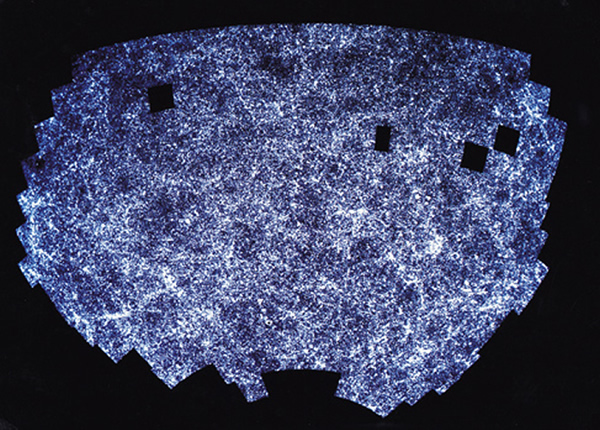
The logic behind Olber's paradox cannot be denied--thus our other assumption, that the Universe is infinite in size, must be wrong! We will find that this is, in fact, one part of the solution to Olbers' paradox. Answering a simple question leads to an amazing conclusion.
Newton's paradox is not quite as famous as Olbers' but the solution is equally surprising. We have found throughout this class that gravity is always at work, whether driving stellar evolution, and the formation of white dwarfs, neutron stars and black holes, or working to keep clusters of stars and galaxies together, or even just keeping our feet fixed to the Earth. Gravity just about always wins in the end. The actual nature of gravity is quite mysterious--it is not clear what is actually responsible for the force of gravity (though go here to read about the "Higgs boson"). Unlike the other forces in nature (strong nuclear, weak nuclear, and electromagnetic), gravity has yet to be adequately explained by physicists. It is clear, however, that gravity works on all matter in the same way---every particle of matter in the Universe pulls on every other particle in the Universe through their mutual gravitational attractions. Gravity always attracts, it never repels. Thus, two bodies that are stationary in space that only feel the gravity of the other body will attract each other, and eventually collide. What can keep this from happening? Motion!
Technically we talk about the universal law of gravitation (Figure 5.11):

The force of gravity depends on the masses of the two bodies (M1, M2), and the distance (d) that separates them. Note that gravity gets weaker quickly: as (1/distance)2. Double the distance, and the force of gravity goes down by a factor of four. But it never disappears! Even objects very far away still pull on you---the effect is very weak from any individual object, but when we start talking about the gravity of billions of galaxies pulling on the gravity of billions of other galaxies, the total force is extremely powerful, and unless there is something to counteract this gravity, all of the galaxies should have collapsed into one big black hole (at least if there has been sufficient time for them to do so).
In the case of moons orbiting planets, or planets orbiting stars, it is the motion of the one body around the other that keeps gravity at bay. We say that the centripetal force of the orbital motion perfectly balances the gravitational attraction, so the one body stays in orbit around the other. One example that you might be familiar with that mimics this idea is a ball/weight attached to a string that you spin around your head:

The string is like the force of gravity, it keeps the ball attached to your hand. You can keep the ball orbiting your head if you twirl the string. If the string breaks, the ball flies off. If you shorten the string the ball must go around faster. Thus, the orbital velocity of planets and stars keep them from merging. The same is true in clusters of stars, or in galaxies, or in clusters of galaxies: the individual objects that make up these structures are in motion, and this motion counteracts gravity's tendency to want to collapse that structure down to a smaller object. We found that stars had a hard time stopping the force of gravity, the only way they could balance gravity was through the generation of energy. A star is too dense for the individual atoms to orbit around their cores. Thus, they eventually lose the fight with gravity, and only electron or neutron degeneracy pressure supplies sufficient force to keep gravity from winning (and this doesn't occur in the case of a black hole).
What about the Universe as a whole? This is Newton's paradox: no matter the size or shape of the Universe, the gravity from all objects within it are constantly pulling on all other objects within it. If the Universe is infinitely old, than the attraction of all of the matter on all of the other matter should have caused the Universe to collapse down into one big ball of matter. Why hasn't this happened? Well there are two possibilities, the first is that the Universe isn't infinitely old, and the second is that there is some other motion in the Universe that keeps gravity at bay. We will find out next class that both possibilities are correct, but the second solution is the actual answer to Newton's paradox.